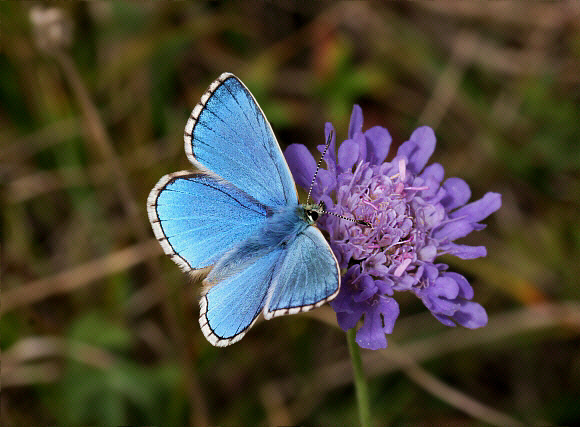 Adonis Blue Polyommatus bellargus, male, Hod Hill, Dorset – Adrian Hoskins
Adonis Blue Polyommatus bellargus, male, Hod Hill, Dorset – Adrian Hoskins
Introduction
The taxonomy of the genus Polyommatus has recently been revised so that it now includes those species formerly placed in Lysandra, Neolysandra, Sublysandra, Plebicula, Elviria, Rimisia, Bryna, Meleageria, Agrodiaetus, Paragrodiaetus and Cyaniris. Defined thus Polyommatus comprises about 220 species, distributed variously across Europe, North Africa, temperate Asia and North America.
The Adonis Blue is found throughout most of the warmer parts of Europe but is absent from Norway, Sweden, Finland, the Mediterranean islands, and all except the southern counties of Britain. Beyond Europe it also occurs in Turkey, and eastward to the Black Sea.
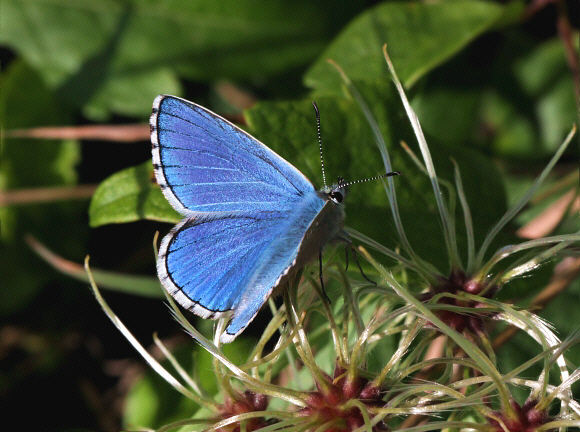
Adonis Blue Polyommatus bellargus, male, Martin Down, Hampshire – Adrian Hoskins
The Adonis Blue, like most other ‘blues’ is sexually dimorphic – only the males have the beautiful overall electric blue colouration. In a photograph it is impossible to convey the brilliance of the blue, which glints in the sunshine and changes hue according to the angle of view.
Females by comparison are dark chocolate brown with a dusting of deep blue scales across the base of the wings. The extent of the blue dusting varies somewhat between individuals. Unlike males, the females also have a dark discal spot on the forewings, and a row of orange sub-marginal lunules on the hindwings. The female of coridon is very similar, but slightly larger and with a dull earthy brown ground colour. It also has suffused whitish edging to the black sub-marginal spots on the upperside, as compared to blue edging in bellargus.
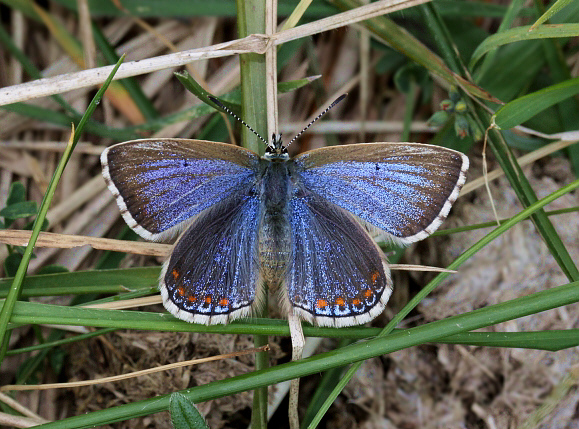
Adonis Blue Polyommatus bellargus, female, Ballard Down, Dorset – Adrian Hoskins
Habitats
In Britain the butterfly is confined to dry chalk and limestone grasslands in the counties of Dorset, Somerset, Wiltshire, Hampshire, the Isle of Wight, Surrey, West Sussex and Kent.
It breeds in compact and dense populations comprising hundreds, or sometimes many thousands of individuals. The populations however are extremely localised – breeding in a restricted area of each site, even if the larval foodplant is widespread. Furthermore movement of adults between nearby sites is extremely unusual – the butterflies seem to find barriers such as roads, cultivated fields or tall hedges virtually impassable.
Most colonies are on south-facing slopes where horseshoe vetch grows in profusion, and which are heavily grazed, producing a short sward pock-marked with patches of bare ground such as those caused by erosion, cattle poaching or rabbit excavations. A very warm microclimate is essential, as even a minor relaxation in grazing can bring about a local extinction. Many colonies are restricted to very localised areas within their sites, e.g. along the south facing ramparts of ancient hill forts, or the west facing bank of a dyke.
In Europe the butterfly is far less fussy about its habitats, and can be found flying along roadsides, or in areas of long grass and scrub on limestone plateaux.
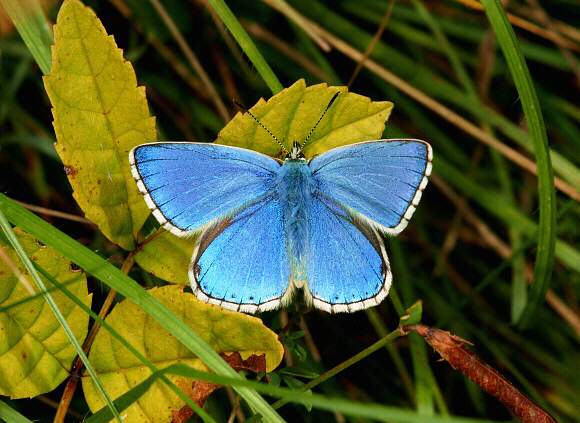 Adonis Blue Polyommatus bellargus, male, Hod Hill, Dorset – Adrian Hoskins
Adonis Blue Polyommatus bellargus, male, Hod Hill, Dorset – Adrian Hoskins
Lifecycle
There are two generations in Britain, the first emerging in May, and the second in late August.
The flat whitish eggs are laid on the underside of terminal leaflets of horseshoe vetch Hippocrepis comosa. There are no alternative foodplants. The butterflies choose plants which are in full sunlight, in sun-baked positions at the edge of rabbit scrapes, paths or other patches of bare ground. The eggs are laid singly, but often several females will visit a particular favoured plant. Consequently as many as 30 can be found in very close proximity.
The larvae feed diurnally. When tiny they feed on the under surface of the leaves where they nibble here and there, producing tiny holes, but leaving the upper cuticle intact. The feeding damage can be seen from above as a peppering of microscopic shiny spots. When older the larvae rest on the upper surface of the leaves but are very well camouflaged and difficult to spot.
They are commonly attended by ants Lasius niger, Lasius alienus or Myrmica sabuleti. The ants are attracted by a sugary secretion which they milk from a gland near the caterpillar’s tail. The larvae seem unable to survive without the ants, whose presence deters other insects that would otherwise attack and kill them. At dusk the larvae retreat to the base of the foodplants, where they assemble in groups of about half a dozen. They are followed by the ants which cover them in a thin layer of soil particles, and stand guard over them during the night.
Adonis Blue larvae ( and those of most other Blues ) appease their attendant ants by ‘singing’ to them, thereby avoiding being eaten themselves. It is not known how the larvae produce their song, although there are microscopic knobs and plates around the opening of the honey gland which may be involved.
Larvae of the second generation enter hibernation almost immediately after hatching, and awaken to begin feeding in March.
When fully grown they are deep green, each segment having a prominent hump. A series of bright yellow dashes runs along each side below the spiracles, and a pair of broken yellow stripes run along the back.
The pupa at first is pale olive, but changes to become straw coloured after a few days. It is formed in crevices on the ground, but ants quickly cover it with a thin layer of soil. Sometimes pupae have been found inside the brood chambers of ants. Immediately prior to emerging from the pupal case, the butterfly produces a crackling song to pacify the ants. It then rapidly breaks through the soil to crawl up a stem where it hangs to dry its wings.
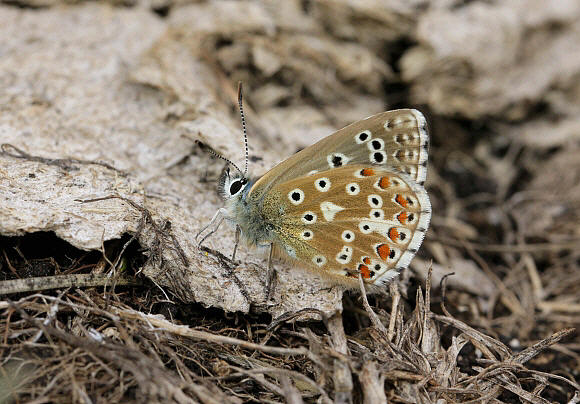
Adonis Blue Polyommatus bellargus, male, Hod Hill, Dorset – Adrian Hoskins
Adult behaviour
Males patrol almost incessantly back and forth across their habitat, fluttering just above the sward in a constant search for females. Periodically however they need to refuel, and stop for a minute or two to nectar at the flowers of horseshoe vetch, bird’s foot trefoil, marjoram, hawkbit or thyme. Occasionally they visit taller plants including thistles, knapweeds and hemp agrimony. They have also been frequently observed gathering to feed at animal droppings.
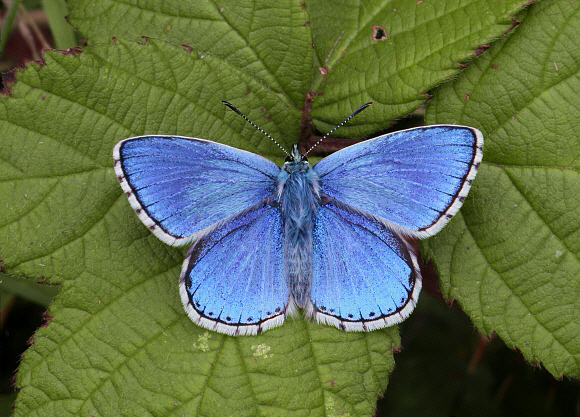 Adonis Blue Polyommatus bellargus, male, Cissbury Ring, West Sussex – Adrian Hoskins
Adonis Blue Polyommatus bellargus, male, Cissbury Ring, West Sussex – Adrian Hoskins
Females are seen far less frequently as they are much less conspicuous, and are usually mated before taking their maiden flight. Copulation occurs without preliminary courtship, at about midday. Copulated pairs, if disturbed will fly a short distance to find a safer resting place.
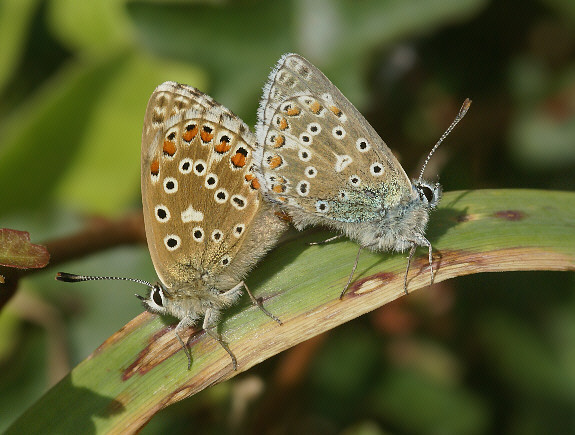 Adonis Blue Polyommatus bellargus, Old Winchester Hill, Hampshire – Adrian Hoskins
Adonis Blue Polyommatus bellargus, Old Winchester Hill, Hampshire – Adrian Hoskins
In hazy sunshine, butterflies of both sexes, including copulated pairs, will bask in rabbit scrapes or other bare patches, with their wings held partly or fully open. On sunny days, as dusk approaches, the butterflies congregate to roost on grass-heads in sheltered areas where tall grasses receive the final rays of the setting sun. They roost head-downwards, often in groups of 20 or 30, with up to 5 individuals on each grass-head.
